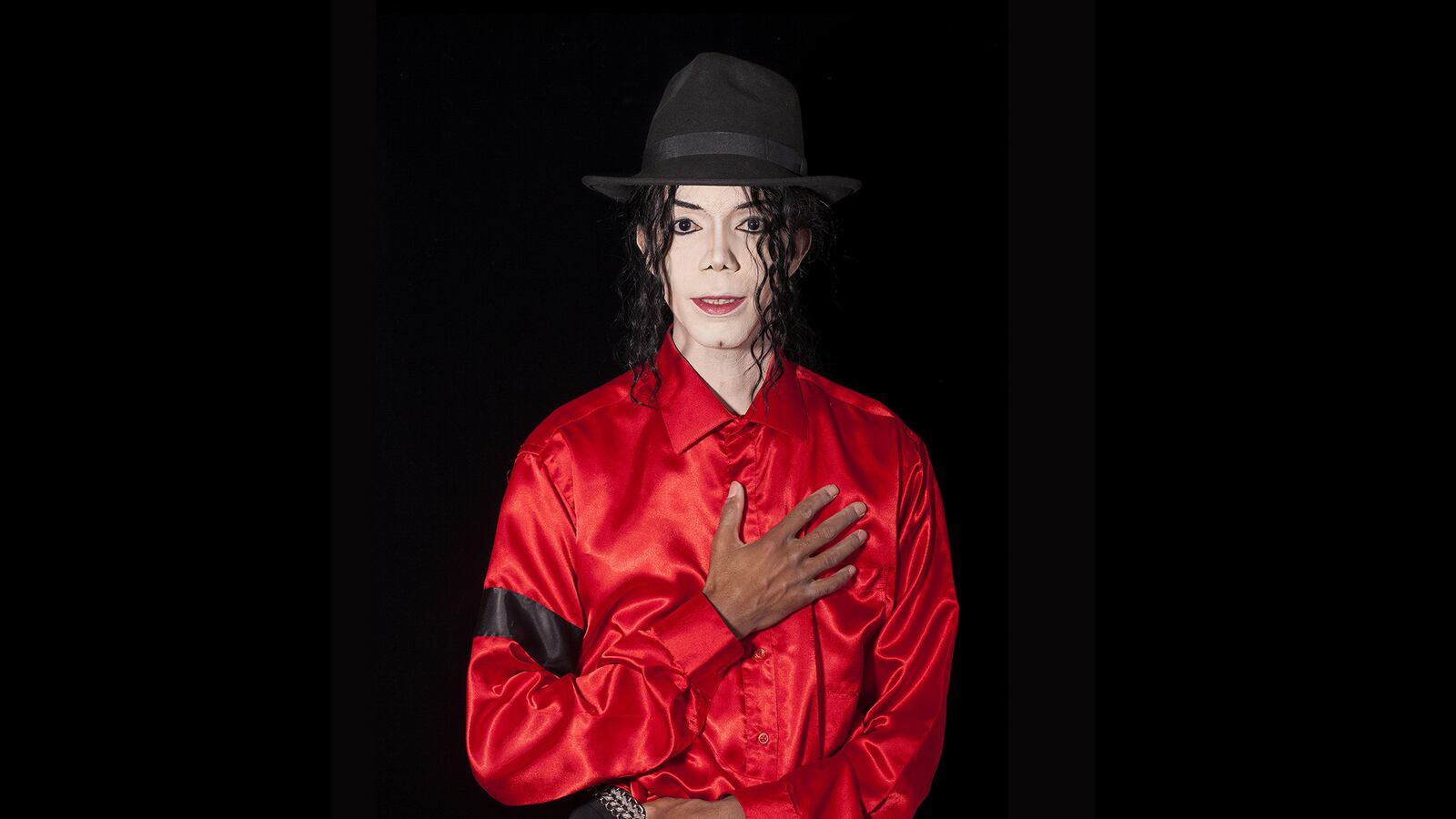It has been five years since Michael Jackson passed away, yet he can still be found moonwalking across the world. Not just in his recently released posthumous album, a holographic performance at the Billboard Music Awards, or museum and hall of fame tributes, but in living, breathing versions of the King of Pop. I’m talking about the sometimes convincing, often entertaining, fanatic world of impersonators.
PHOTOS: The Many Michael Jacksons Honor an Icon

Lorena Turner, author of The Michael Jacksons, recognized the sub-culture of Jackson impersonators shortly after his death on June 25, 2009.
When she visited the famous Apollo Theater in Harlem where the Jackson 5 had their debut performance in 1967, swarms of fans had gathered to pay their respects. But, to Turner, the most fascinating aspect was the tribute artists—those men and women dressed in full Jackson costume, moon walking, singing, and posing for pictures with the crowd.
A few weeks later, in Los Angeles, performers from the West Coast gathered with fans outside of the Staples Center where the official memorial service was being broadcast worldwide. “The play and flow of identity enacted by the Michael Jacksons continued to intrigue me in the weeks after the memorials,” Turner writes in The Jacksons. So, she decided to contact those who make it their life’s work to embody one of the most loved celebrities of recent generations and explore their lives, their works, and the ways in which their art transforms our culture, specifically in terms of race, gender, and sexuality.
For many, the career is chosen because of a passion for the performer while also acting as a way to support their families. Jen Amerson, a 37-year-old single mother from South Carolina, makes enough from performing at parties and family reunions throughout the state to provide for her two children. “For her it really is just a workable, satisfying way to make a living,” Turner writes. “When the DuPont plant where she had worked for more than ten years shut down, and, soon after, she and her husband divorced, Jen turned a loving obsession with Michael Jackson into a good job.” During her travels, Turner encountered performers with rates up to $400 an hour.
But, among the group of mostly male impersonators, Amerson is unique in that she is one of the few female Jackson performers that Turner came across. That, coupled with her Caucasian race and her location in the small-town South, made her a fascinating person for Turner to observe.
Turner was most interested in people performing in smaller cities because “they don’t have the kind of social lens to reflect back to them” the way that larger cities do. “It’s definitely a different thing to do in the South,” Amerson told Turner. “But ultimately it is what the Michael Jacksons are all about—expressing something different within the common character of Michael Jackson and exploring—and expanding—the boundaries of race, class, gender, and ultimately, humanity.”
Jackson faced a lot of scrutiny when it came to his own appearance and lifestyle. “In the 80s he was developing as an African American artist,” Turner told The Daily Beast. “But through the 90s, he became indefinable. The question of race, ethnicity, gender, and sexuality, all of these basic questions that we define ourselves by seemed to be things that he was transcending.”
His impersonators also transcend these defining qualities. By taking on the Michael Jackson persona, they “transcend skin color, racial identity and gender identity, delighting and unsettling audiences, and even, at times, challenging their own notions of self.”
Jovan Rameau, a Haitian immigrant, graduated from the Institute of Advanced Theater Training at Harvard. “[He] saw impersonating [Jackson] as both a stepping stone to an acting career,” Turner writes, “and a way to liberate himself from what he describes as the confines of being black and Haitian in the U.S.”
Working as a busboy in Miami during the 1980s, Rameau often faced racism due to his ethnicity. He found confidence in his resemblance to Jackson and noticed the respect the King of Pop received from white Americans. He began performing as a way to overcome the prejudices and, after a break to study at Harvard, he can now be found at Jackson’s star on the Hollywood Walk of Fame most days of the week, waiting for his big break in the entertainment industry.
These impersonators and performers don’t stand alone in their efforts to entertain; they are a community. Multiple times a year—mostly on important dates relating to Jackson’s life—they come together to meet, dance, and celebrate the person they have devoted their lives to alongside the many fans that adored him.
Each year, thousands of people gather in Gary, Indiana to celebrate his birthday. When Jackson passed away in 2009, actor and director Spike Lee began organizing a massive celebration of the performer’s legacy in Brooklyn’s Prospect Park. And Thrill the World, which takes simultaneously in different cities across the globe, invites fans to join together to break the World Record for the largest real-time dance to “Thriller.” The synchronized dance has locations from the West Indies to Austria and Hong Kong to Australia.
According to Turner, there is a very large community that is always growing. “The community that I became familiar with two or three years ago is not the same,” she says. “They are incredibly supportive of each other and many of them know each other through online interactions, but some also develop real romantic relationships with each other.”
During one visit to photograph performers from Newark, NJ, Turner brought together Dominique Wilson, who goes by the stage name Mikette, and two male impersonators. Since that time, Mikette’s relationship with one of the performers she met that day has grown. They are now engaged and have begun performing together. “This online thing is incredibly important grounds for validating your choices to be Michael Jackson,” Turner said. “And it also allows them to support each other because they have to be very comfortable with what they are doing.”
The diverse group of performers that Turner came to know not only embody the physicality of Jackson, but also the way in which he disrupted cultural and societal norms. Throughout his many transformations in his own life, Jackson’s was, overall, a supreme entertainer. Just like Jackson, the impersonators mesmerized their audiences with their performances. Their acts honor a legend and remind us of his lasting cultural impact.
The Michael Jacksons will be available for purchase on August 26, 2014.




